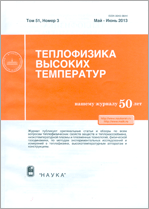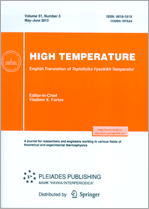|
This article is cited in 35 scientific papers (total in 35 papers)
Thermophysical Properties of Materials
Thermophysical properties of boron carbide irradiated by ionizing radiation
M. N. Mirzayevab, Kh. F. Mammadova, R. G. Garibova, E. B. Asgerovbc
a Institute of radiation problems, ANAS
b Joint Institute for Nuclear Research, Dubna, Moscow region
c National Nuclear Research Center, Baku, Azerbaijan
Abstract:
Differential-scanning calorimetry is used to study the thermophysical properties of boron carbide irradiated by the ionizing radiation from the $^{60}\rm Co$ source. With increased temperature, the heat capacity and entropy values of nonirradiated and irradiated $\rm B_4 \rm C$ specimens increase. At high temperatures $(723$–$1300$ K$)$, the character of variation of the enthalpy and the Gibbs' potential of the irradiated $\rm B_4 \rm C$ specimen depends on the presence of oxygen. The values of the thermodynamic functions vary due to the formation of excited atoms, active centers, defects of the $\rm B_4 \rm C$ crystal structure, and $\rm B_4\rm C$ oxidation in the presence of the air oxygen after the ampoule opening. Also possible is an increase, at $723$–$1300$ K, in the rate of oxidation of the boron carbide surface (contacting with the air oxygen), where the defects that form upon irradiation are distributed. At temperatures above $723$ K, melting of the oxygenated part $(\rm B_2\rm O_3)$ in $\rm B_4\rm C$ specimens irradiated by the absorbed dose of $194$ Gy is observed; that process continued until the transformation of $\sim 26\%$ of crystal structure into the amorphous phase at $1300$ K.
Received: 10.03.2017
Accepted: 10.10.2017
Citation:
M. N. Mirzayev, Kh. F. Mammadov, R. G. Garibov, E. B. Asgerov, “Thermophysical properties of boron carbide irradiated by ionizing radiation”, TVT, 56:3 (2018), 390–394; High Temperature, 56:3 (2018), 374–377
Linking options:
https://www.mathnet.ru/eng/tvt10831 https://www.mathnet.ru/eng/tvt/v56/i3/p390
|


|





 Contact us:
Contact us: Terms of Use
Terms of Use
 Registration to the website
Registration to the website Logotypes
Logotypes








 Citation in format
Citation in format 
